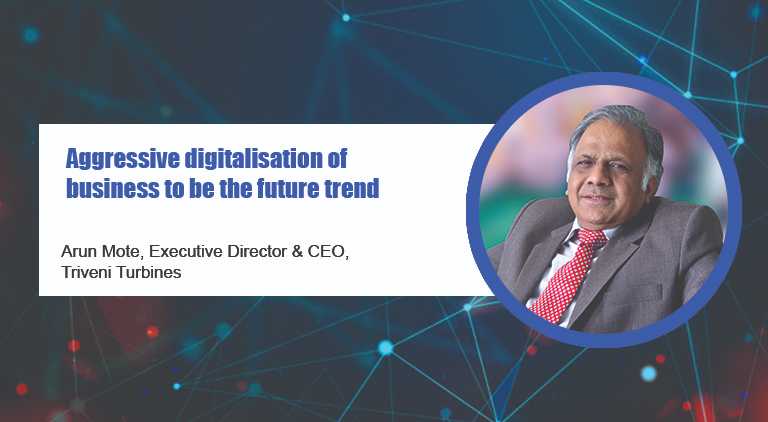Aggressive digitalisation of business to be the future trend
By EPR Magazine Editorial January 27, 2021 4:15 pm IST
By EPR Magazine Editorial January 27, 2021 4:15 pm IST

Arun Mote, Executive Director & CEO, Triveni Turbines, in an interview with EPR Magazine, talk about leveraging advanced technologies in power sector to boost their businesses and provide quality deliverance to the power sector.
India’s power demand reached an all-time high capacity of 182888 MW on 30th December 2020. How do you evaluate a demand for distributed generation with this?
It is high-time that we move away from centralised generation system towards distributed generation system, with focus on nouvelle energies. The entire burden of meeting the nation’s energy requirements cannot be shouldered on the Government and large power plants. As we pace for the next decade of burgeoning manufacturing and industrial growth, we need to create self-sufficient ecosystems away from the existing hubs, leading to decentralised growth. With the advent of new technologies in energy generation, it is imperative to leverage them to contribute to the economic development with a sustainable approach. We are witnessing the adoption of captive power generation by companies engaged in activities beyond manufacturing e.g. IT and food processing industries. This is a testament to the potential of decentralised power generation as well as its ability to help the country meet its carbon-emissions targets.
Triveni Turbine manufactures industrial steam turbine in the sub 30 MW power rating meeting the captive and renewable power solution requirement of the customers in India and abroad, with installation in 70+ countries across the globe. The need for continuous uninterrupted quality power supply for sustainable industrial operations, backed by improvement in coal supply, will enhance the captive power additions in the country. According to Ministry of Power, the installed captive power generation capacity (above 1 MW capacity) associated with industry-owned plants is 78,000 MW as of 31 March 2020. It is expected that the installed captive power generation capacity in India to growth around 5-6 percent over the next 3 years, till 2023. This will augment the demand for steam turbines in the captive power generation segment in the future.
What are the latest technologies being implemented in your facility?
We are a global leader in the 5-30 MW turbines space; and have been able to sustain our leadership position through continuous technology upgradation undertaken through our dedicated R&D programme. Our in-house R&D expertise along with support from the reputed national and international technical institutes, domain knowledge experts as well as the consultants from India and abroad leads to well-engineered product solutions for our global customers. We have also carried out experimental validation of turbine steam path, such as cascade testing of aerofoil and in-house load testing of upgraded blade-path.
We carry-out technology enhancement through continuous multi-generational product programs. These have enabled the company to offer its clients with robust product along with customised higher efficiency with lower carbon-footprint and lower CAPEX and OPEX costs resulting in higher customer revenue. The products thus developed enable faster start-up cycles to increase uptime
As part of the continuous product upgrade, high efficiency compact series turbines are introduced which reduces carbon footprints, running and maintenance cost of the TG set. In order to meet the market needs, sector specific requirements, product upgrades in process co-generation, on waste heat application (Cement segment) and distillery segment has been introduced.
Further, the company also works globally across all brands of rotating equipment, leaving a positive footprint on repair, spares, overhauling, and efficiency improvements etc up to 300MW. This is done by using specialized 3D white-light scanners to develop the drawings required for any brand/make of turbines. The part is then 3D printed to ensure the correct fitment before mass manufacturing.
How has COVID-19 impacted your business?
What are your plans and projections for the financial year of 2021-22?With our strong balance sheet, debt-free status and adequate cash, we are confident of covering our liquidity needs, going forward. We aim to improve our margins and global market share across the business segments.
We shall also continue to augment our focus on technological deployment to ensure greater cost optimisation with enhanced business productivity, as we automate and upgrade our array of software in 2021. The investment of the past few years in streamlining the systems and processes across the manufacturing and supply chains will yield benefits as we work on more innovative solutions to address the needs of our customers, across industries and geographies, in the new normal.
Aggressive digitalisation in all aspects of the business shall be the way forward. The past 2-3 months have seen our teams equip with latest digital tools and applications for achieving the business objectives by using the ‘new normal’ means. Cumulatively, we feel these efforts shall translate into greater `normalcy’ and revival in the months ahead. From supporting Triveni’s aggressive transformation during the COVID-19 crisis, to paving the way for further reinforcement of its digital security architecture, this technological empowerment promises to be a game-changer as we move towards post-COVID era.
Our teams are equipped with latest digital tools and applications for achieving the business objectives by using the ‘new normal’
Arun Mote, Executive Director & CEO, Triveni Turbines
We use cookies to personalize your experience. By continuing to visit this website you agree to our Terms & Conditions, Privacy Policy and Cookie Policy.